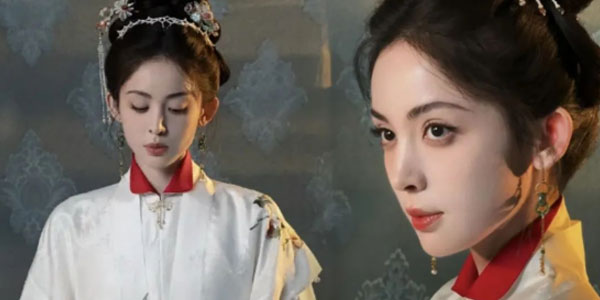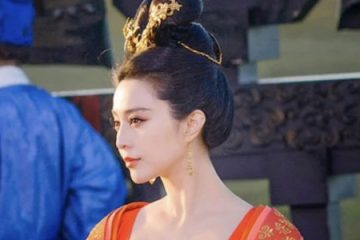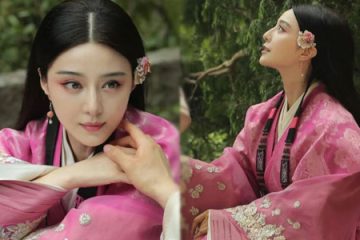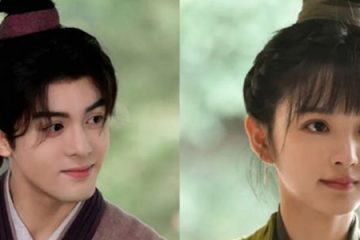Did Ming Dynasty Hanfu Have a Polo Shirt Style? New Knowledge Gained!

Let’s take a look at the recent stills of Gulnazar wearing Hanfu. The way she wears the turned-up collar is quite trendy. It turns out that in the Ming Dynasty, the Chinese already had something similar to a polo shirt? I can’t help but complain that the combination of this red turned-up collar and the white clothes really looks a lot like my high school uniform. This shows that many aspects of aesthetics are actually the same in ancient and modern times, and the aesthetics of Hanfu are really ahead of their time.
I. The Way of Wearing Ming Dynasty-style Hanfu with a Turned-up Collar
This is an adjusted way of wearing a standing collar. Previously, some people criticized that Ming Dynasty-style Hanfu doesn’t show the neck well and is likely to wrap around the neck, making the face look bigger. This method of wearing a turned-up collar is a great solution. It not only provides more choices in dressing but also allows you to undo the collar part to dissipate heat in summer. It really serves multiple purposes.
Moreover, the Ming Dynasty clothing similar to polo shirt styles was very popular. In fact, a short-sleeved standing-collar slant-front shirt was unearthed from a Ming Dynasty tomb. Generally, when we see a small piece of white folded collar exposed in ancient paintings, it might be the effect of wearing such a short garment underneath. I initially speculate that this short garment meets several key elements of an inner garment. One is that it is plain or light-colored, which is more versatile and suitable for matching with outer garments of various colors. The other is that it uses drawstring instead of buttons, so it won’t affect the wearing of the outer garment when putting it on.

If you still remember what we popularized before, that the inner garment paired with the round-collar robes in the Tang Dynasty was also in the style of half-sleeved garments (banbi), you’ll understand why half-sleeved garments are often chosen as inner garments. One reason is to regulate body temperature during hot weather, and the other is to serve as a kind of layering like a shirt and to create a distinct silhouette.

Not only for inner garments, but even for formal outerwear, the collar can be turned up. In the new drama, Gulnazar’s images wearing standing-collar shirts mostly feature the style of turned-up collars. In this way, it’s less likely to wrap around the entire neck, making the face look smaller. It also gives a sense of fashion and allows the color of the collar lining to be revealed. Generally, you just need to undo the buttons at the collar and fold it outward. Looking at it this way, doesn’t it seem exactly the same as the way modern shirts are worn and the effect of their turned-up collars?


There have been many similar ways of wearing turned-up collars in previous Chinese dress movies and TV dramas, and the modifying effects of the turned-up collars are more or less the same. It can not only break the fixed style of traditional dressing but also truly make the outline of the entire face more prominent, and it won’t press down on the neck and make the neck look short. Generally, the lining of the collar can be the same color as the clothes, and it is often white. Of course, it can also be a different color. When turning up the collar, some contrasting colors can be revealed. For example, red can add a touch of embellishment to the overall plain and elegant outfit.

II. Small Adjustments in the Way of Wearing Make a Big Difference
However, there are also several different ways to turn up the standing collar, which probably need to be adjusted according to the occasions of wearing. I have simply summarized them. The common ones are large turned-up collars, angular turned-up collars, and folded turned-up collars. For a large turned-up collar, the entire collar is turned up halfway, presenting a triangular effect. For an angular turned-up collar, only a small corner is turned up (in the style shown in the picture below), symbolically turning up just a little bit. The folded turned-up collar is more formal, folding it completely along the edge to align it with the collar. The first one looks more casual, and the latter two are a bit more formal. So, even for turned-up collars, there are differences in how much of the collar is turned up, the angle of the fold, and the color matching of the turned-up collar.

In fact, besides the Ming Dynasty clothing that can have turned-up collars, many manufacturers that make horse-face skirts (also mamian skirt) also take into account the needs of the main group of consumers (white-collar workers) and combine the traditional ma mian skirts with modern shirts. In this way, the horse-face skirt sets are very suitable for occasions such as work and commuting. This is also a small source of comfort for Hanfu enthusiasts. After all, it’s a good thing that Hanfu can keep up with the times and be accepted by everyone. The style in the picture below is a case of combining a shirt collar with a horse-face skirt. It is not only beautiful but also rich in cultural connotations. This style is also available on our website.

There is also a more minimalist style that is quite suitable for commuting. Although the design is simple, it has achieved remarkable sales results. In a word, Hanfu is very suitable for friends who like various styles to give it a try.

Summary

Although there are still many speculations about the styles of the turned-up collars, we can also see the many charms of the turned-up collars in the Ming Dynasty. With just a small collar, through simple manual operations, you can create different styles. Moreover, you can continuously adjust the actual effect of the turned-up collar according to your face shape and the occasion. Next time, if anyone questions that our ancestors were not fashionable, you can confidently say: Wearing a polo shirt? It already existed in the Ming Dynasty. Is it ahead of its time? Well, not really. It’s just that we know too little about the Chinese clothing culture of the past.



0 Comments